February 2004
A new definition for the phrase "pen computing"
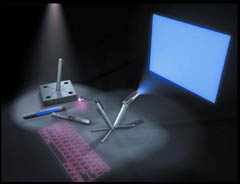 NEC has created a fascinating prototype of the wearable computer of the near future, one composed entirely of five interconnected pens.
NEC has created a fascinating prototype of the wearable computer of the near future, one composed entirely of five interconnected pens.
From the article:
"One pen is a CPU, another a camera, one creates a virtual keyboard, another projects the visual output and thus the display and another a communicator. All five pens can rest in a holding block which recharges the batteries and holds the mass storage. Each pen communicates wireless, possibly Bluetooth."
Click here to read the article at Wave Report. -- Posted Monday, February 23, 2004 by davidmacneill
Coming soon, an easy way to connect your iPod to your car
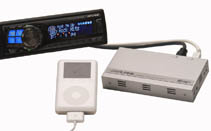 Lovers of Apple's iPod digital music player have used a variety of hacks to pipe their music into their car sound systems, but no off-the-shelf solution thus far has been seamless. To fill the need, Alpine has announced a version of their popular 900-watt receiver that will fully integrate late model iPods into the system using a single cable, allowing full access to iPod functions from the dash controls.
Lovers of Apple's iPod digital music player have used a variety of hacks to pipe their music into their car sound systems, but no off-the-shelf solution thus far has been seamless. To fill the need, Alpine has announced a version of their popular 900-watt receiver that will fully integrate late model iPods into the system using a single cable, allowing full access to iPod functions from the dash controls.
Click here to download the press release in PDF (42Kb). -- Posted Monday, February 16, 2004 by davidmacneill
Samsung i700 and i600 to get Windows Mobile 2003 updates
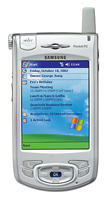
 After a delay of over half a year, Samsung has finally committed to delivering updated Windows Mobile software for their popular SPH-i700 Pocket PC Phone Edition and SCH-i600 Smartphone devices. The following quotes are from their developer site, with links:
After a delay of over half a year, Samsung has finally committed to delivering updated Windows Mobile software for their popular SPH-i700 Pocket PC Phone Edition and SCH-i600 Smartphone devices. The following quotes are from their developer site, with links:
"An update to Windows Mobile Pocket PC Phone Edition 2003 will be available at Verizon Wireless retail store locations in early 2004." Click here to visit the Samsung Mobile Intelligent Terminal Developer Community.
"An update to Windows Smartphone 2003 will be available at Verizon Wireless retail store locations in early 2004." Click here to visit the Samsung Mobile Intelligent Terminal Developer Community. -- Posted Monday, February 16, 2004 by davidmacneill
Psion looking at Linux
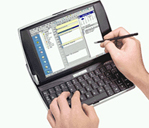 Now that Psion-Teklogix no longer controls Symbian, the company is looking to the future in the form of Linux-based handhelds and notebook computers. Knowledgeable insider Guy Kewney has written an interesting article on the subject that includes some illuminating comments from Psion chief David Potter.
Now that Psion-Teklogix no longer controls Symbian, the company is looking to the future in the form of Linux-based handhelds and notebook computers. Knowledgeable insider Guy Kewney has written an interesting article on the subject that includes some illuminating comments from Psion chief David Potter.
Click here to read the article at NewsWireless.net. -- Posted Wednesday, February 11, 2004 by davidmacneill
PalmSource announces Cobalt
PalmSource today announced their new OS strategy, which renames Palm OS 5 and 6 as Garnet and Cobalt respectively. Both versions will support wireless technologies, including a telephone interface. Cobalt will offer multitasking, multithreading, memory protection, support for more memory (up to 256MB RAM and 256MB ROM) and larger screens, better security, and will include graphics and multimedia features derived from the BeOS which Palm Inc acquired in 2001. Developers attending PalmSource 2004 received new software development tools in the form of a "technical preview" or beta for Palm OS Cobalt and Garnet, which is also available in the Resource Pavilion in the PalmSource Developer Zone. The new Palm OS Developer Suite is based on the Eclipse environment, originally developed by IBM. It supports C, C++, Java and COBOL. -- Posted Tuesday, February 10, 2004 by sab
Meet ike: Pocket PC-based GIS multifunction device
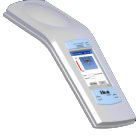 Here's a promising new device for surveyors, field inspectors, or anyone else who needs to capture detailed, location-specific data. Surveylab's new ike is a handheld device that integrates a laser distance meter, GPS receiver, electronic compass, digital camera, and inclinometer, all controlled by Microsoft's Pocket PC 2003 operating system.
Here's a promising new device for surveyors, field inspectors, or anyone else who needs to capture detailed, location-specific data. Surveylab's new ike is a handheld device that integrates a laser distance meter, GPS receiver, electronic compass, digital camera, and inclinometer, all controlled by Microsoft's Pocket PC 2003 operating system.
Click here to visit the Surveylab website. -- Posted Tuesday, February 10, 2004 by davidmacneill
Missing Sync to provide new Mac connectivity options
Later this year, Mark/Space will deliver a new version of their popular Missing Sync application that will enable comprehensive connectivity between next-generation "Cobalt" Palm devices and Macs. The new version will also support the Tapwave Zodiac, which lacks the ability to sync with a Mac. Currently, Missing Sync goes beyond iCal and Address Book syncing to provide connections to other apps, such as iPhoto, iTunes, AvantGo, FileMaker, Entourage, and more.
Click here to read the story at MacCentral. -- Posted Tuesday, February 10, 2004 by davidmacneill
Tapwave Zodiac 2 review posted
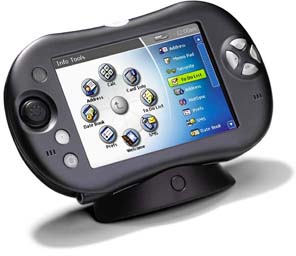 "Every few years, a device comes along that defies easy categorization. The people who are paid to market such devices have to work twice as hard, since they must not only sell the machine, but also position it in a previously uninhabited niche of our collective minds.
"Every few years, a device comes along that defies easy categorization. The people who are paid to market such devices have to work twice as hard, since they must not only sell the machine, but also position it in a previously uninhabited niche of our collective minds.
Tapwave's new Zodiac is such a device. Envisioned as a console-class portable gaming platform as well as a state-of-the-art Palm-powered PDA, its designers have achieved something remarkable: the Zodiac does both things well -- very well."
Click here to read the review. -- Posted Tuesday, February 10, 2004 by davidmacneill
Bluesnarfing: Coming to America?
One sure sign that a new technology has become commercially successful is when it becomes vulnerable to security attacks. Sony-Ericsson is looking into the growing problem of Bluetooth security in their mobile phones and Nokia has admitted that their 6310, 6310i, 8910, and 8910i mobiles can, under certain circumstances, be robbed of their phonebook and other data without the victim being aware it has happened. Some mobiles can also be crashed remotely by being the recipient of a deliberately corrupted SMS message. Such tactics, collectively known as "bluesnarfing", shows that Bluetooth has reached critical mass -- at least in Europe where these security problems are now occurring. Can the US be far behind?
Click here to read the story at ZDNet UK. -- Posted Tuesday, February 10, 2004 by davidmacneill
Securing data on stolen laptops
Backing up is not enough. Laptop computers containing critical data are stolen every day, most lacking even rudimentary forms of security such as login passwords or document encryption. A number of companies have moved to fill this security gap, with solutions ranging from USB key backup systems to LoJack-style locators.
Click here to read story at Wired News. -- Posted Monday, February 9, 2004 by davidmacneill
Nokia takes control of Symbian
Nokia is buying one-third of Psion's stake in Symbian, the jointly-owned operating system for smartphones. Symbian evolved from Psion's OS for their handheld computers, which once dominated the handheld market in Europe but never achieved critical mass in the US. Speculation naturally arises that other Symbian partners -- such as Sony-Ericsson, Matsushita, and Samsung -- will do what Motorola did five months ago and pull out of the Symbian consortium entirely, leaving Nokia to battle with Palm and Microsoft in the smartphone OS wars.
Click here to read story at CNET News -- Posted Monday, February 9, 2004 by davidmacneill
Siemens PenPhone
Siemens Mobile has announced they will show at CeBIT next month a working prototype of their new PenPhone, a 140 millimeter x 19 millimeter device that uses an unspecified handwriting recognition technology to enter phone numbers or SMS messages.
Click here to read story at InfoWorld -- Posted Monday, February 9, 2004 by davidmacneill
 Lovers of Apple's iPod digital music player have used a variety of hacks to pipe their music into their car sound systems, but no off-the-shelf solution thus far has been seamless. To fill the need, Alpine has announced a version of their popular 900-watt receiver that will fully integrate late model iPods into the system using a single cable, allowing full access to iPod functions from the dash controls.
Lovers of Apple's iPod digital music player have used a variety of hacks to pipe their music into their car sound systems, but no off-the-shelf solution thus far has been seamless. To fill the need, Alpine has announced a version of their popular 900-watt receiver that will fully integrate late model iPods into the system using a single cable, allowing full access to iPod functions from the dash controls. NEC has created a fascinating prototype of the wearable computer of the near future, one composed entirely of five interconnected pens.
NEC has created a fascinating prototype of the wearable computer of the near future, one composed entirely of five interconnected pens. 
 After a delay of over half a year, Samsung has finally committed to delivering updated Windows Mobile software for their popular SPH-i700 Pocket PC Phone Edition and SCH-i600 Smartphone devices. The following quotes are from their developer site, with links:
After a delay of over half a year, Samsung has finally committed to delivering updated Windows Mobile software for their popular SPH-i700 Pocket PC Phone Edition and SCH-i600 Smartphone devices. The following quotes are from their developer site, with links: Now that Psion-Teklogix no longer controls Symbian, the company is looking to the future in the form of Linux-based handhelds and notebook computers. Knowledgeable insider Guy Kewney has written an interesting article on the subject that includes some illuminating comments from Psion chief David Potter.
Now that Psion-Teklogix no longer controls Symbian, the company is looking to the future in the form of Linux-based handhelds and notebook computers. Knowledgeable insider Guy Kewney has written an interesting article on the subject that includes some illuminating comments from Psion chief David Potter. Here's a promising new device for surveyors, field inspectors, or anyone else who needs to capture detailed, location-specific data. Surveylab's new ike is a handheld device that integrates a laser distance meter, GPS receiver, electronic compass, digital camera, and inclinometer, all controlled by Microsoft's Pocket PC 2003 operating system.
Here's a promising new device for surveyors, field inspectors, or anyone else who needs to capture detailed, location-specific data. Surveylab's new ike is a handheld device that integrates a laser distance meter, GPS receiver, electronic compass, digital camera, and inclinometer, all controlled by Microsoft's Pocket PC 2003 operating system. "Every few years, a device comes along that defies easy categorization. The people who are paid to market such devices have to work twice as hard, since they must not only sell the machine, but also position it in a previously uninhabited niche of our collective minds.
"Every few years, a device comes along that defies easy categorization. The people who are paid to market such devices have to work twice as hard, since they must not only sell the machine, but also position it in a previously uninhabited niche of our collective minds.